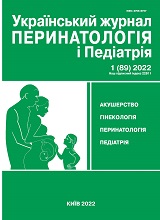Risk factors of gastrointestinal food allergy in young children
DOI:
https://doi.org/10.15574/PP.2022.89.22Keywords:
gastrointestinal food allergy, risk factor, vitamin D, young childrenAbstract
Purpose - to study risk factors of gastrointestinal food allergy (GIFA) in young children.
Materials and methods. 68 young children with GIFA and 22 children of the same age with an unencumbered individual allergy history were examined. A study of children perinatal, family and individual allergy history was conducted, and a survey was conducted on the state of parents’ health. The vitamin D supply of children was determined by quantifying of serum 25-hydroxycalciferol (25(OH)D) concentration by using an immunochemical analyzer.
Results. Anamnestic risk factors that showed a significant association with the development of GIFA in young children and reliably differed from the control group were: complicated obstetric history, medical treatment of mothers during pregnancy, early artificial feeding, burdensome family allergy history and gastrointestinal diseases presence in parents. Insufficient supply of vitamin D was in 79.4% of patients with GIFA compared with 13.6% of children in the control group. The average serum 25(OH)D value in children with GIFA was 34.18±1.7 ng/ml, which is significantly lower than in the control group (40.2±2.3 ng/ml; p<0,05), which may be an additional factor in the development and severity of the disease.
Conclusions. Risk factors of gastrointestinal food allergy have been identified, which will improve the prevention, early diagnosis and treatment of gastrointestinal allergic disease.
The research was carried out in accordance with the principles of the Helsinki declaration. The study protocol was approved by the Local ethics committee of the participating institution. The informed consent of the patient was obtained for conducting the studies.
No conflict of interests was declared by the author.
References
Caubet JC, Szajewska H, Shamir R, Nowak-Wegrzyn A. (2017, Feb). Non-IgE-mediated gastrointestinal food allergies in children. Pediatr Allergy Immunol. 28 (1): 6-17. https://doi.org/10.1111/pai.12659; PMid:27637372
Errazuriz G, Lucero Y, Ceresa S, Gonzalez M, Rossel M, Vives A. (2016). Clinical characteristics and management of infants less than 1 year old suspected with allergy to cow's milk protein. Rev Chil Pediatr. 87 (6): 449-454. https://doi.org/10.1016/j.rchipe.2016.06.007; PMid:27634007
Gupta RS, Springston EE, Warrier MR et al. (2011). The prevalence, severity and distribution of childhood food allergy in the United States. Pediatrics. 128 (1): e9-17. https://doi.org/10.1542/peds.2011-0204; PMid:21690110
Ho MHK, Wing WHS, Chang C. (2014). Clinical spectrum of food allergies: a comprehensive review. Clinical Reviews in Allergy and Immunology. 46 (3): 225-240. https://doi.org/10.1007/s12016-012-8339-6; PMid:23229594
Holick MF, Binkley NC, Bischofferrari HA et al. (2011). Evaluation, treatment, and prevention of vitamin D deficiency: an Endocrine Society clinical practice guideline. J Clin. Endocrinol Metab. 96: 1911-1930. https://doi.org/10.1210/jc.2011-0385; PMid:21646368
Koletzko S, Heine RG, Grimshaw KE et al. (2015). Non-IgE mediated cow's milk allergy in Euro Prevall. Allergy. 70 (12): 1679-1680. https://doi.org/10.1111/all.12681; PMid:26769086
Muraro А, Werfel Т, Hoffmann-Sommergruber К et al. (2014). EAACI food allergy and anaphylaxis guidelines: diagnosis and management of food allergy. Allergy. 69 (8): 1008-1025. https://doi.org/10.1111/all.12429; PMid:24909706
Nwaru BI, Hickstein L, Panesar SS, Muraro A, Werfel T, Cardona V et al. (2014, Jan). On behalf of the EAACI Food Allergy and Anaphylaxis Guidelines Group. The epidemiology of food allergy in Europe: a systematic review and meta-analysis. Allergy. 69 (1): 62-75. https://doi.org/10.1111/all.12305; PMid:24205824
Pae M, Wu D. (2017). Nutritional modulation of age-related changes in the immune system and risk of infection. Nutr Res. 41: 14-35. https://doi.org/10.1016/j.nutres.2017.02.001; PMid:28577789
Poole A, Song A, Brown H, Hart PH. (2018, Jul). Cellular and molecular mechanisms of vitamin D in food allergy. J Cell Mol Med. 22 (7): 3270-3277. https://doi.org/10.1111/jcmm.13607; PMid:29577619 PMCid:PMC6010899
Prescott SL, Pawankar R, Allen KJ et al. (2013). A golabl survey of changing patterns of food allergy burden in children. World Allergy Organization Journal. 6: 21. https://doi.org/10.1186/1939-4551-6-21; PMid:24304599 PMCid:PMC3879010
Downloads
Published
Issue
Section
License
Copyright (c) 2022 Ukrainian Journal of Perinatology and Pediatrics

This work is licensed under a Creative Commons Attribution-NonCommercial 4.0 International License.
The policy of the Journal “Ukrainian Journal of Perinatology and Pediatrics” is compatible with the vast majority of funders' of open access and self-archiving policies. The journal provides immediate open access route being convinced that everyone – not only scientists - can benefit from research results, and publishes articles exclusively under open access distribution, with a Creative Commons Attribution-Noncommercial 4.0 international license(СС BY-NC).
Authors transfer the copyright to the Journal “MODERN PEDIATRICS. UKRAINE” when the manuscript is accepted for publication. Authors declare that this manuscript has not been published nor is under simultaneous consideration for publication elsewhere. After publication, the articles become freely available on-line to the public.
Readers have the right to use, distribute, and reproduce articles in any medium, provided the articles and the journal are properly cited.
The use of published materials for commercial purposes is strongly prohibited.

